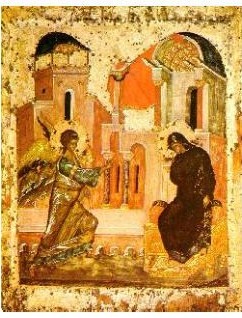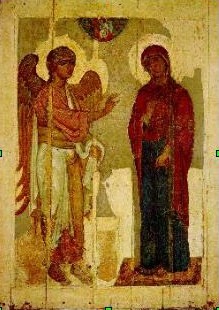|
Speaking Icons
|
|
| Former-Teacher | Date: Saturday, 13.11.2010, 09:52 | Message # 1 |
 Dean
Group: Admins
Messages: 504
Status: Offline
| What icons do you know? What do they mean? What do they communicate to people? To believers and non-believers?
|
| |
|
|
| Nadya | Date: Saturday, 13.11.2010, 15:55 | Message # 2 |
 Union committee president
Group: Moders
Messages: 213
Status: Offline
| Icons are very important in the life of believers. We have icons too. They really help us in difficult situations. For example, a lot of sick people pray in front of icons.They just believe. And most of them become healthy again. A lot of drivers can be non-believers but they have icons in their cars. Do you think they believe that the icon can save them or is it just a "tradition"? Is it enough just to have an icon in the house or do we also have to go to church?
|
| |
|
|
| Tanya | Date: Thursday, 25.11.2010, 02:33 | Message # 3 |
 Course monitor
Group: Friends
Messages: 61
Status: Offline
| All icons are symbolic. They unite the visible and the invisible, the material side of life and the spiritual one. If you are a believer, church or home icons help you to understand and remember thoughts of God. They are like a unique symbol which helps people to create a sacred space around them.
|
| |
|
|
| lovefootball) | Date: Thursday, 25.11.2010, 07:47 | Message # 4 |
 Dean
Group: Users
Messages: 662
Status: Offline
| Nadya, I guess some people buy icons just inspiredly. They see that this or that icon is supposed to heal, help and so on and buy it in the hope of a miracle. Maybe they don't believe but are driven to despair. So, traditions are also involved here.
|
| |
|
|
| Asya | Date: Friday, 26.11.2010, 05:21 | Message # 5 |
 Union committee president
Group: Moders
Messages: 298
Status: Offline
| I tend to think that icons are so to say tokens, totems, amulets. People have always had a desire to be able to withstand nature, to be equal rivals in this unequal battlefield of life. But they understood they were not powerful enough. That's why different talismans and charms appeared. In different lands, in different religions, both in paganism and in Christianity. Nowadays medicine is on a much higher level that in those times but people have always had and will always have various life-situations that threaten their lives. A need for safety and protection is a natural human need.
|
| |
|
|
| Fr_Arsenios | Date: Saturday, 27.11.2010, 11:43 | Message # 6 |
|
Student
Group: Users
Messages: 10
Status: Offline
| I know many different icons: icons of God, Mother of God, saints, about feasts, etc. Icons mean the image of the person who is depicted in it. When we pray in front of the icon, we address to the foretype (the first image). So, we have a possibility to communicate with this person. This is what is important in our faith. So, the icons are not amulets, totems, charms etc. It is not an icon (I mean as a simple object of wood and paints) that saves a person, but the one who is depicted in it. The icon can help only when we understand its meaning, but not when we use it as an amulet.
|
| |
|
|
| lovefootball) | Date: Saturday, 27.11.2010, 19:43 | Message # 7 |
 Dean
Group: Users
Messages: 662
Status: Offline
| Agree, they are like, I don't know, a fine thread, something that brings us nearer to God, that makes our life easier and simpler. They can save a person if he has no one to reveal a secret to. Actually, the list can be endless, it all depends on a person and his attitude towards all that.
|
| |
|
|
| Rina | Date: Monday, 29.11.2010, 11:30 | Message # 8 |
 Union committee president
Group: Friends
Messages: 208
Status: Offline
| Quote (Fr_Arsenios) So, the icons are not amulets, totems, charms etc.
Actually, historically icons ARE totems. All the pagan tribes had a tradition to create certain totems that represented the spirit they worshipped, they all created this “visual image” of gods. Christians borrowed this tradition as many others in order to make the conversion to Christianity less painful.
|
| |
|
|
| beymlina_julia | Date: Wednesday, 01.12.2010, 23:17 | Message # 9 |
 Student
Group: Users
Messages: 6
Status: Offline
| The icons represent the vast conception of God, its (I prefer its to his[i]) boundless mercy and sever punishment.
They are meant as the objects of worship, their task is to convey religious doctrines to a considerable number of people
(as, of course, not everybody would trouble themselves by reading the Bible - visual perception has more influence on one's mind than cognitive one)
Byzantine masters denoted the episodes of paramount importance to the understanding of Christianity in their icons; never did they hesitate to depict a detailed story just in one icon.
|
| |
|
|
| Fr_Arsenios | Date: Saturday, 18.12.2010, 11:27 | Message # 10 |
|
Student
Group: Users
Messages: 10
Status: Offline
| Quote (Rina) Actually, historically icons ARE totems.
Ok,your oppinion is very interesting. Where did your find this information? In the Bible? In the popular magazines? In fiction or atheistic literature? Or did anybody tell you so? As far as I know, there are two billion christians in the world. More than half of them won't agree with you. If you write such critical statements, you must at least support your arguments by historical facts. It would be interesting if you gave such examples.Added (18.12.2010, 11:27)
---------------------------------------------
Quote (beymlina_julia) The icons represent the vast conception of God, its (I prefer its to his[i]) boundless mercy and sever punishment.
God doesn't punish anybody. This is not a dogmatic concept, but it is used to interpret and describe some knowledge of Christianity. A human being punishes himself. The most important concept in Christianity is salvation. In Christianity God doesn't demand a victim of us, but He Hemself offers His own victim to save all people.
|
| |
|
|
| MissJane | Date: Thursday, 09.06.2011, 21:49 | Message # 11 |
 Union organizer
Group: Friends
Messages: 193
Status: Offline
| Quote (beymlina_julia) visual perception has more influence on one's mind than cognitive one
I think pretty much the same. People need to have visual representation of the god they worship. The initial meaning of Christian icons was, to my mind, to embody God, the saints, to depict scenes from the Bible and not to protect people from harm. Believers try to show their vision of God, to express their devoted love to Him when painting icons. An icon inherits a great power if the heart of the believer who's standing before it is full of love, contrition and hope.
|
| |
|
|
| Luck | Date: Tuesday, 21.02.2012, 14:52 | Message # 12 |
|
Union organizer
Group: Friends
Messages: 172
Status: Offline
| The first and probably the main thing that makes me pay close attention to the icon “The Nativity” is the excellence of its composition through which we can understand the message conveyed by the painter. Some images are depicted quite clearly, others not, and their amount does not allow us to understand everything very well. In the same time, in spite of the fact that the icon is very colorful, it does not distract us from the main figures and the main spiritual ideas that are represented in the icon. The main event that the icon is connected with is the birth of Jesus. At the central part of the icon we can see his mother – Mary, she is the largest and the most important figure as well. Her presence, her physical state that shows us that she has just given birth to her son is the central idea the author wanted to transfer. She is surrounded with angels, the messengers of God and the people who are happy to see the mother of our God and her baby. She represents the woman who has fulfilled God’s will and who has just brought a baby, who will save all the believers, into our world.
|
| |
|
|
| Ayayulia | Date: Tuesday, 21.02.2012, 15:08 | Message # 13 |
 Union organizer
Group: Friends
Messages: 126
Status: Offline
| The most interesting thing about this picture (The Nativity) is that though Mary is the centre of our attention she is not a most important participant. Every character is of vital importance and fulfills its own function that completes the image of Mary who represents the power, mercy, and fulfillment of God's will. And this is not only the message of the icon, but also the main character, the main concept. I have also found a description of the icon in a poetic form.
Today the Virgin gives birth to the Transcendent One,
And the earth offers a cave to the unapproachable One!
Angels with shepherds glorify Him!
The Wise men journey with the Star!
Since for our sake the Eternal God
Was born as a little child! YouTube
This icon makes a very mild and pleasant impression on me because of its colour and the concept itself. Every birth is a wonder, and here we see the most wonderful birth, the Birth of Jesus Christ.

|
| |
|
|
| MissJane | Date: Tuesday, 21.02.2012, 15:10 | Message # 14 |
 Union organizer
Group: Friends
Messages: 193
Status: Offline
| The Nativity is the icon that bears the features of a monumental chronicle which represents a number of holy depictions. This makes the icon a unique time line that stretches both in time and space. The central and the largest figure in the icon is Mary who in fact is symbolic in nature: she is an embodiment of virtue, goodness, deliverance, and observance of God’s will. Mary is the mother of our Savior, the redeemer of our sins and saver of our souls.
Being a specimen of traditional iconography, the Nativity icon is an assembly of several events. Mary and her husband, the pious Joseph, were forced to stay in a limestone cave because they hadn’t found a place to stay in Bethlehem. The birth of the Incarnate Son of God took place here, on a cold winter night lighting up the Earth with His sanctity. The word of this spread throughout the region, that’s why a few shepherds are depicted on the icon. The Nativity of Christ was also known to the Magi who came to venerate this event with some gifts. The day of the Nativity is commemorated by the Church and the believers every year being preceded by a short fast. As the day is considered to be the beginning and the basis for the Church year, the icon of the Nativity should be ranked among the underlying ones.
|
| |
|
|
| Rina | Date: Tuesday, 21.02.2012, 15:18 | Message # 15 |
 Union committee president
Group: Friends
Messages: 208
Status: Offline
| by Rina and Asya
The Annunciation represents one of the most significant Biblical events. The scene depicted in it represents the angel visiting Mary in order to announce the Will of God. The composition of the icon is based on the contrast between the moving angel and motionless Mary. The angel's heavenly origin is emphasized by his beautiful gold blue-green garments. Dark clothing worn by Mary stands for humankind, humility and agreement. But despite this contrast the icon is well-balanced because the darkness of Mary's clothing corresponds to the dark colours of the roofs in the background. But when comparing this icon to the Annunciation of Ustyug we can't but mention that though the figures lack some of the later icon's movement, they are, nevertheless, equally impressive in their monumentality and spirituality. Hence the analysis of these two icons vividly shows that the traditions of Russian iconography preserve Byzantine heritage, infusing it with specific Russian mentality.
The icons are:
1. The Annunciation, Moscow School, 14th century 2. The Annunciation of Ustyug, Novgorod, 1110-30
 
|
| |
|
|
|












